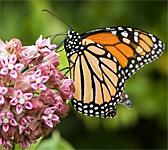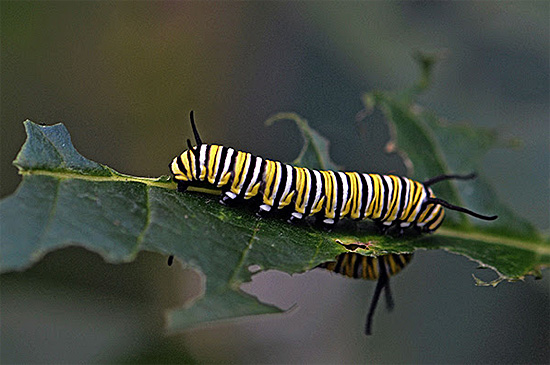2023 International Monarch Monitoring Blitz
 The International Monarch Monitoring Blitz is back for its seventh edition. From July 28 to August 6, 2023, Espace pour la vie invites you to join thousands of volunteers across Canada, Mexico, and the United States and support monarch butterfly conservation. To take part in this trinational initiative, simply share your monarch and milkweed observations via the Insectarium Mission Monarch program.
The International Monarch Monitoring Blitz is back for its seventh edition. From July 28 to August 6, 2023, Espace pour la vie invites you to join thousands of volunteers across Canada, Mexico, and the United States and support monarch butterfly conservation. To take part in this trinational initiative, simply share your monarch and milkweed observations via the Insectarium Mission Monarch program.
For a 10-day period, the International Monarch Monitoring Blitz invites people in North America to find milkweed plants and look for monarch eggs, caterpillars, chrysalises, and butterflies. Last year more than 6,000 observations were collected, creating a ripple effect for monarch conservation across North America. In fact, observations submitted by volunteers help identify priority areas for monarch conservation and guide conservation actions. The data collected during the Blitz will be made available for anyone to download and consult via the Trinational Monarch Knowledge Network, a central repository that features data from various sources and helps researchers perform large-scale temporal and spatial analyses.
The Blitz is the only coordinated trinational effort to capture a snapshot of the monarch and milkweed summer distribution. This information is crucial to help the scientific community understand and measure the reproductive success of the monarch breeding population as well as long-term population trends.
As mentioned in the Canada Gazette, there is a proposed order to amend the List of Wildlife Species at Risk by reclassifying the monarch butterfly from special concern to endangered.
In Mexico, the monarch butterfly is officially listed as a species at risk under Norma Oficial Mexicana 059 since 2010.
In the United States, the U.S. Fish and Wildlife Service (USFWS) determined that listing the monarch butterfly as an endangered or threatened species was warranted but precluded by higher-priority listing action. According to Mara Koenig, a Public Affairs Specialist at USFWS, the agency is expected to submit a proposed rule to the Federal Register for the monarch, if still warranted, under the Endangered Species Act by September 30, 2024.
With the conservation of the monarch butterfly gaining momentum across North America, now is the time for communities to go out into nature and take part in this initiative.
Participating programs for monarchs
To take part in the Blitz, please share your observations through one of the participating community science programs below:
Canada:
United States:
Mexico:
The Monarch Blitz is organized by the Trinational Monarch Conservation Science Partnership, a collaboration of organizations, including the Commission for Environmental Cooperation (CEC), the Comisión Nacional de Áreas Naturales Protegidas du Mexique, Environment and Climate Change Canada (ECCC), Insectarium | Montréal Space for Life, Journey North, the Monarch Joint Venture, Profauna A.C., the Fish and Wildlife Service and the Xerces Society for Invertebrate Conservation.
Quotes about monarch blitz
“I invite everyone to take part in the International Monarch Monitoring Blitz this summer. More than ever, we need data on this migratory butterfly, whose populations have declined substantially. We can no longer take for granted that we will see a monarch butterfly in our gardens, fields, and by the roadside. They need our protection, and the International Monarch Monitoring Blitz is a simple and effective way for you to help. By reporting what you see over a 10-day period, you’ll join people from across North America who are contributing to the survival of the monarch butterfly in a very real way. Mark the dates, get some friends, and go observe this natural work of art in its habitat! ,” said the Honorable Steven Guilbeault, Minister of Environment and Climate Change Canada.
“In placing observation, documentation, and understanding of nature at the center of their approach all at the same time, community-science activities are a bridge between a sense of wonder, knowledge development and the feeling of contributing—three elements necessary for a paradigm shift. They create connections between the population and scientists: they generate productive collaborations. In that sense they are a fantastic tool for protecting the environment and for preserving biodiversity,” said Julie Jodoin, director of Espace pour la vie.
“In Mexico, we need to know what happens with the local populations of monarch butterflies during the summer. By participating in the International Monarch Monitoring Blitz, we will help generate key information to understand where these local populations are, if they are reproducing, what species of milkweed they use during the summer to reproduce, and then be able to establish the most appropriate actions for the conservation of these local populations of monarch butterflies,” said Jerónimo Chávez, Project Manager of the Correo Real Program at PROFAUNA A.C.
“I started seeing monarchs about five summers ago and realized I might have something cool in my yard attracting them. A quick search led me to the Monarch Blitz, and I became hooked! I found milkweed all over my yard and vowed to make my backyard a sanctuary for pollinators,” said Lindsay, one volunteer with Journey North in the United States.
Community science at Espace pour la vie
Aligned with the priorities of the Montréal 2030 strategic plan, the mission of Espace pour la vie is to bring people close to nature, to inspire them and to encourage them to adopt behaviors that foster the socioecological transition. It is in that context that numerous programs at the local, national, and international level have been implemented, including the following community science projects run by the Insectarium de Montréal:

(Photos courtesy of Espace pour la vie)






